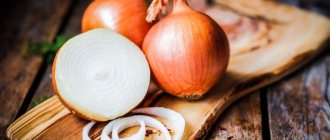Red onions contain vitamin C, potassium, calcium, iron, fiber, protein and sulfur. The sulfur components and flavonoids in red onions are believed to reduce the risk of cancer and heart disease. Red onion has antibacterial, antiviral and antiallergic effects.
1. Onion components lower cholesterol, improve the cell membrane of red blood cells, and prevent heart disease.
2. Red onion increases bone density and has a significant effect on menopausal women, reducing the risk of fractures and osteoporosis.
3. The antioxidants in red onions play a special role in the immune system and serve against inflammatory reactions.
4. Red onion reduces the risk of cancer (colon cancer, throat cancer, ovarian cancer, breast cancer). However, a small amount does not matter; you should take at least one bulb per day.
5. Other Benefits: Fights bacteria, has anti-toxic effects, supports gut health, stimulates hair growth, lowers sugar levels and fights diabetes.
Composition and beneficial properties of red onion
The amount of antioxidants in red onions is twice as high as in white onions. Antioxidants have a positive effect on the human body - they prevent cancer and cardiovascular diseases, and premature aging.
The color of onions is due to the presence of anthocyanins in them. These substances contribute to:
- combating bacterial diseases and inflammation in the body;
- alleviation of nervous disorders and cancer;
- preventing diabetes.
Quercetin in red onions has unique antitumor properties and helps reduce the risk of allergic reactions, swelling and spasms. The sulfur found in onions prevents blood cells from sticking together and cholesterol from accumulating. The microelement improves blood composition, is useful for the prevention of atherosclerosis, and quickly removes cholesterol. The red vegetable contains a lot of chromium. This element reduces the percentage of sugar in the blood, as a result of which the cells begin to better perceive insulin and the risk of developing diabetes mellitus decreases.
Red onion is a natural antioxidant.
When applied externally, its juice disinfects the skin. When consumed internally, it destroys germs and viruses and strengthens the immune system. Onion juice is included in folk recipes for the treatment and prevention of colds and pneumonia. Red vegetable juice is very useful for the acidic environment of the stomach. It improves metabolism and improves digestion. It is often used on menus by obese people to lose weight.
The vegetable helps get rid of worms. To do this, eat the product daily before each meal or use its tincture for an enema.
Red onion promotes better blood circulation in the head. A mask based on it is one of the best in the fight against hair loss: it stimulates the growth of new hair follicles.
Onion peel helps in the fight against calluses. It must be filled with vinegar, left for 10 days and applied as compresses to rough areas of the skin. Onions also help with oral infections, headaches, and salt deposits. It is used in the form of decoctions, juice, tinctures internally or externally. With frequent consumption of red vegetables, the general condition of the body improves.
Benefits for men
The red vegetable will also be of great benefit to representatives of the stronger sex, who need testosterone to maintain male power. Purple onions increase it several times.
The vegetable activates the immune system, improves erection, increases libido and sperm quality.
Can pregnant and breastfeeding women eat onions?
The beneficial properties of onions are due to the large amount of vitamins and minerals. For this reason, it is simply necessary for pregnant women to eat it. Eating vegetables helps:
- avoid colds;
- prevent the development of anemia and vitamin deficiency;
- strengthen the musculoskeletal system and nervous system of mother and child;
- prevent constipation due to the presence of magnesium;
- protect the baby from the development of pathologies of the central nervous system due to the presence of folic acid;
- improve digestion with essential oils.
If pregnant women have no contraindications, red onions can be safely consumed in reasonable quantities. You should stop using it only if you are prone to metabolism and in the second half of pregnancy - in order to avoid allergic reactions.
Among the Slavs, red onion is considered one of the most popular products, the beneficial properties of which are due to its rich chemical composition. Even the simplest dish acquires an exquisite taste and aroma with it.
It is impossible to replace it with a white relative, because the composition of nutrients is completely different. Red tastes more pleasant than white, it has no bitterness, it is juicier and sweeter.
Beneficial features
This vegetable is an important source of nutrients. Its rich chemical composition makes it an indispensable food product. It is difficult to overestimate the importance of red onions for human health.
The largest amount of nutrients in it is stored in its raw form. After thermal and any other treatment, most of them are lost.
The vegetable can prevent disorders and diseases of internal organs. Its consumption strengthens the immune system, improves digestion and increases appetite. But that’s not all that red onions are good for.
- Valuable substances such as anthocyanins and antioxidants effectively help fight viral infections. They also have a powerful preventive effect against diabetes, nervous system disorders, the appearance of malignant tumors and aging.
- This vegetable can prevent heart disease. It cleanses blood vessels and improves their condition.
- Quercetin reduces allergy symptoms, relieves swelling and cramps.
- Improves blood circulation in the skin, which is why the vegetable is often used to make masks. After using them, hair begins to grow better and stops falling out.
- The invaluable benefits of red onions include preventing the development of atherosclerosis and improving blood composition.
- People with stomach problems should use it to eliminate congestion and improve the production of gastric juice.
- Onions cleanse the body of toxins and activate metabolism, which is why it is recommended to be consumed for obesity. Its low calorie content allows you to add it to any dietary dishes, making the food more juicy and tasty.
- Eating half an onion daily prevents helminthiasis.
- Pregnant women are recommended to take a small amount of red vegetable to prevent vitamin deficiency, strengthen the baby’s musculoskeletal system and nervous system. With regular use, anemia can be avoided.
- Helps men increase testosterone and restore physical strength. Onion juice improves sperm quality and increases libido.
Red onions are a real treasure not only for cooks, but also for doctors. People who want to lead a healthy lifestyle should definitely eat this vegetable.
Harm and contraindications
It is important to know not only about the beneficial properties, but also about the contraindications to consuming red onions:
- severe kidney and liver dysfunction;
- colitis;
- skin diseases;
- flatulence and pancreatitis;
- increased stomach acidity;
- asthma and hypertension.
If you experience an allergic reaction to this product, you should exclude it from your diet.
Healthy people do not need to overuse this vegetable: you can eat no more than 100 g per meal.
Use in folk medicine
Due to its wide range of beneficial properties, red onion has found application not only in cooking, but also in folk medicine, where it can be used as a good remedy in the fight against liver ailments, colds, helminthic infestations and diabetes. In addition, there is information about its benefits in prescriptions for prostatitis.
For liver treatment
Red onion juice contains a lot of substances that have a positive effect on the functioning of the body's main cleansing organ - the liver.
They help remove toxins and normalize its activity, and to prepare such a therapeutic and prophylactic drug you will only need a few finely chopped onions (500 g) and almost the same amount of sugar (450 g).
Having combined them together, you need to place the resulting pulp in a glass container and store it in a dark and cool place. After 10 days, take out the mixture, squeeze out the juice and consume 3 tbsp. l. per day, half an hour before meals. The course of treatment is 1–3 weeks, but it is better to discuss the duration of therapy with your doctor. It is interesting that for diseases of the gallbladder and gastrointestinal tract, the use of the described remedy is contraindicated, so if there are similar disorders in the body, then you will have to find another option.
Important!
Onions and sugar should not be infused in the refrigerator; if possible, it is advisable to find a basement or other similar room with similar conditions.
You should also not consume onion juice if you have a functional liver disorder; it is better to use the infusion only as a prophylactic for cleansing the organ and against cirrhosis.
For a cold
For colds, folk recipes in many cases become an excellent alternative to store-bought pharmaceutical drugs, not only relieving symptoms, but also improving the general condition of the body. One such healthy food is red onion, which can be enhanced by mixing it with honey.
At the first manifestations of a cold, the juice from two heads of red vegetable must be combined with honey in exactly the same proportions and taken 20 ml 4-5 times a day, without washing anything down. The course of treatment is 3-4 days or until the symptoms disappear completely, however, if you have stomach problems, you should look for another, milder remedy.
For diabetes
If you have high blood sugar levels or to prevent the development of diabetes, you can consume a mixture of 3 tbsp. l. green beans, finely chopped blueberry leaves and onion juice (in the same quantity).
The resulting composition is poured with water and boiled for 20 minutes. Take the medicine in a chilled state, 3 tbsp. l. in a day. The course of treatment is up to 2 weeks, although sometimes it is better not to exceed a week (for example, for the same stomach diseases).
For prostatitis
Onions have always been considered one of the most effective ways to increase libido and sperm quality in men, so it is not surprising that the red variety can be used for medicinal purposes for prostatitis. In the acute stage, an infusion of two crushed heads of vegetables and 0.5 liters of boiling water will help, which after a half-hour infusion should be taken 50 ml every hour.
As an alternative, you can mix onion seed powder with the same amount of honey and consume 1 tsp of the finished mixture. three times a day. If you believe the reviews, then this remedy also helps a lot in cases where prostatitis is triggered by the development of sexually transmitted diseases (in particular, syphilis, gonorrhea, etc.).
Did you know?
In the 1st century n. e. diabetes was considered the result of a snake bite, and the term itself appeared thanks to the ancient Greek physician Aretaeus, who practiced medicine in Cappadocia.
From helminths
Red onion is known for its disinfecting effect, so it is used as an ingredient in medicinal mixtures for helminths. The recipe for preparing the drug is simple: 1 medium onion must be peeled and cut into two parts, pour 240 ml of hot water.
The resulting composition is infused for 7 hours, and then taken 80 ml of the drink twice a day before meals. The course of treatment is 5 days. In a word, even such a simple vegetable as red onion contains a lot of useful qualities, so before considering alternative treatment options, it is worth trying to use it for medicinal purposes.
Red onions differ from white onions in taste and shade, but the chemical list of elements in both types remains practically unchanged. Its purple counterpart is more often used in cooking and folk healing. With its help, they improve immunity and fight viral infections. The beneficial and harmful qualities of the hot vegetable have been studied in detail, so today we will look at the main characteristics.
- During the period of gestation, the fair sex is allowed to include almost all foods in their daily diet. It is important to consume them in reasonable quantities. This way you can avoid vitamin deficiency.
- As for the contraindications for consuming red onions, they are absolutely the same as in everyday life. Do not exceed the daily amount of the product. If you are prone to flatulence, you should avoid eating onions in the second trimester.
- If you are an onion lover and you have not identified any contraindications, you should not deprive yourself of the pleasure of eating the vegetable. The unique composition will protect the baby from viruses and infections. In addition, you will saturate your body with vitamins.
- Onions contain unique phytoncides. Enzymes actively resist fungi and pathogens. Essential oils, in turn, improve metabolism. Folic acid prevents the development of pathologies in the baby.
- The mineral compounds in the vegetable help mother and baby strengthen the nervous system and musculoskeletal system. Magnesium solves the problem of constipation. Regular consumption of purple product prevents the development of anemia and vitamin deficiency.
- Including onions in your daily diet will help you avoid colds. It is believed that the foods that the expectant mother consumed during pregnancy will be well received by the baby in the future.
Nutritional value and chemical composition
100 grams contain 42 kilocalories. One onion consists of 90% carbohydrates, 8% proteins and 2% fats.
The rich chemical composition of red onion has made it a natural medicine. It is distinguished by a significant content of fiber, vitamins A, C, group B and other useful substances such as potassium, cobalt, sulfur, boron, iodine, magnesium, fluorine, calcium, phosphorus and sodium.
Red onions are a storehouse of valuable substances, which, in the absence of contraindications, should be included in the daily diet of every person.
If you find an error, please select a piece of text and press Ctrl+Enter
.
Contents of the article: Red onion is one of the very popular types of ordinary onions. A distinctive feature is the purple-red color scheme. The taste is sweetish-spicy, and the bitterish taste is not very pronounced. The countries of Central Asia are considered the homeland of this red beauty. And it was brought to Crimea in the 19th century from Portugal. The most popular varieties of red vegetables in the world are Yalta, Romanov and onions from Tropea, from Italy. This crop is grown in Ukraine, Russia, Belarus, and many countries in Europe and Central Asia.
Composition and calorie content of red onion
Red onion is very tasty, and its benefits are no less than those of a regular vegetable, and perhaps even more.
Calorie content of red onion is 40 kcal per 100 grams of product, of which:
- Proteins - 1.1 g;
- Fats - 0.1 g;
- Carbohydrates - 9.34 g;
- Water - 86 g;
- Fiber - 1.7 g;
- Ash - 1 g;
- Sugar - 4.24 g.
Vitamins per 100 g:
- Vitamin B1, thiamine - 0.046 mg;
- Vitamin PP (nicotinic acid) - 0.5 mg;
- Beta Carotene - 1 mcg;
- Beta Cryptoxanthin - 47 mcg;
- Lutein + Zeaxanthin - 4 mcg;
- Vitamin B2, riboflavin - 0.027 mg;
- Vitamin B4, choline - 6.1 mg;
- Vitamin B5, pantothenic acid - 0.123 mg;
- Vitamin B6, pyridoxine - 0.12 mg;
- Vitamin B9, folate - 19 mcg;
- Vitamin C, ascorbic acid - 1 mg;
- Vitamin E, alpha tocotrienol - 0.04 mg;
- Vitamin E, alpha tocopherol - 0.02 mg;
- Vitamin K, phylloquinone - 0.4 mcg.
Macroelements per 100 g:
- Aluminum, Al - 400 μg;
- Boron, B - 200 μg;
- Iodine, I - 3 mcg;
- Potassium, K - 146 mg;
- Calcium, Ca - 23 mg;
- Magnesium, Mg - 10 mg;
- Sodium, Na - 4 mg;
- Phosphorus, Ph - 29 mg.
Microelements per 100 g:
- Iron, Fe - 0.21 mg;
- Cobalt, Co - 5 μg;
- Manganese, Mn - 0.129 mg;
- Copper, Cu - 0.039 μg;
- Selenium, Se - 0.5 μg;
- Fluorine, F - 1.1 μg;
- Zinc, Zn - 0.17 mg.
Essential amino acids per 100 g:
- Arginine - 0.104 g;
- Valine - 0.021 g;
- Histidine - 0.014 g;
- Isoleucine - 0.014 g;
- Leucine - 0.025 g;
- Lysine - 0.039 g;
- Methionine - 0.002 g;
- Threonine - 0.021 g;
- Tryptophan - 0.014 g;
- Phenylalanine - 0.025 g.
Essential amino acids per 100 g:
- Alanine - 0.021 g;
- Aspartic acid - 0.091 g;
- Glycine - 0.025 g;
- Glutamic acid - 0.258 g;
- Proline - 0.012 g;
- Serine - 0.021 g;
- Tyrosine - 0.014 g;
- Cystine - 0.004 g.
Lipids per 100 g:
- Fatty acids, saturated - 0.042 g;
- Fatty acids, monounsaturated - 0.013 g;
- Fatty acids, polyunsaturated - 0.017;
- Phytosterols - 15 mg.
Of the digestible carbohydrates in red onion, per 100 grams of product contains only mono- and disaccharides (sugars) in the amount of 8.1 g.
Beneficial properties of red onion
This onion variety has reddish flesh and purple skin.
It is very rich in vitamins and various minerals. There are most of them near the husk, so you need to clean it as carefully as possible. It loses a third of its strength when we peel it off too thickly. The benefits of red onion and dishes containing it:
- Reduces the risk of diseases such as cancer
. This onion variety contains more antioxidants than its white counterpart. Thus, it reduces the risk of cancer. In addition, quercetin contained in onions provides an antitumor effect. - Prevents diseases of the cardiovascular system
. This happens thanks to the same antioxidants. - Helps with colds
. Anthocyanins, which give the peel a purple tint, help fight inflammation and bacterial diseases. Being a natural antiseptic, they destroy viruses inside our body. They also help strengthen the immune system. - Reduces allergic reactions, swelling and spasms
. This is due to the quercetin found in red onions. - Prevents the accumulation of cholesterol in the body
. Sulfur, found among the beneficial substances of onions, prevents blood cells from sticking together and thereby inhibits the increase in cholesterol by 20% (approximately 3-5 onions per week). In addition, the vegetable improves blood composition. - Helps with diabetes
. The microelement chromium, which red onions are rich in, reduces the concentration of sugar in the blood. The body's cells perceive insulin better, and the likelihood of developing this disease is limited. - Helps with secretory deficiency
. A couple of tablespoons of red onion juice has a beneficial effect on the acidity of the stomach. - Improves digestion
. This red vegetable helps normalize metabolism. Supports metabolism. - Promotes weight loss
. If you constantly eat red onions, the body takes in various groups of sulfur, which help reduce intoxication in the body and lead to weight loss. - Helps with gum diseases
. For this purpose, it is recommended to eat red onion feathers. - Rejuvenates the body
. The red vegetable slows down its aging.
Many beneficial substances in red onions have a healing or preventive effect if consumed regularly, because vitamins, minerals and other life-giving components must accumulate in the body.
Health Benefits of Red Onion
1. Onion components lower cholesterol, improve the cell membrane of red blood cells, and prevent heart disease.
2. Red onion increases bone density and has a significant effect on menopausal women, reducing the risk of fractures and osteoporosis.
3. The antioxidants in red onions play a special role in the immune system and serve against inflammatory reactions.
4. Red onion reduces the risk of cancer (colon cancer, throat cancer, ovarian cancer, breast cancer). However, a small amount does not matter; you should take at least one bulb per day.
5. Other Benefits: Fights bacteria, has anti-toxic effects, supports gut health, stimulates hair growth, lowers sugar levels and fights diabetes.
Possible harm of red onions
Consuming red onions can aggravate stomach pain and also increase gastrointestinal irritation, leading to unpleasant side effects such as nausea and diarrhea.
People with a gastrointestinal tract disorder may exhibit allergic symptoms. In this case, it is recommended to limit the intake of raw onions.
You should take it with caution in case of heart, kidney, liver failure, breast and prostate diseases.
Red onion and testosterone
It has been scientifically proven that red onion extract increases the hormone testosterone several times.
For men, testosterone is responsible for reproductive function. A lack of this hormone can reduce a man's quality of life. Red onion promotes health, fights fatigue, improves mood, prevents obesity, normalizes erections, stimulates hair growth, and increases the likelihood of conceiving a child. Onion juice increases the production of testosterone and sperm, improves sperm quality (after 20 days of drinking juice in the proportion of 1 g/kg body weight/day), greatly increases libido.
But pregnant, lactating women, and small children are not recommended to take onions in large quantities. While progesterone and estrogen are the primary female hormones, testosterone is equally important to a woman's physical and sexual well-being. In particular, due to low testosterone levels in women, there is a decrease in libido and sexual stamina, and the risk of breast cancer increases.
It is better to replace currently common food additives, dietary supplements and testosterone stimulants with natural red onion juice!
You might also like:
The benefits of pumpkin for the body of women and men. The benefits of pumpkin porridge What are the benefits of garlic for the human body. How harmful is garlic to the circulatory system and pancreas? The benefits and harms of horseradish for the body The benefits of radishes for the human body. Radishes are harmful to health. The benefits and harms of boiled beets for the body. The benefits and harms of fresh beets for the human body. The benefits and harms of turnips for men and women. The benefits and harms of olives and canned olives.
Today, perhaps, you won’t surprise anyone with red onions. This vegetable differs from its white relative not only in appearance, but also in taste and composition.
The benefits and harms of red onions should also be considered separately, since this variety has an absolutely unique set of vitamins, chemical elements and other nutrients.
Red onion contains many vitamins.
Traditional healers have known about the healing properties of the vegetable for a long time, so they boldly include it in treatment regimens for vascular atherosclerosis, hypercholesterolemia, diseases of the digestive tract, women's diseases, and colds.
Harm and contraindications to eating red onions
No matter how useful red onion is, it, too, like any vegetable, has contraindications.
These restrictions on use are associated with the pungent taste of the product. This type of onion should be eaten with caution:
- People suffering from colitis. For these ailments, you should adhere to a dietary diet, and onions are not included in the list of permitted foods.
- Patients with high stomach acidity. Red onions cause irritation by increasing the acidity of gastric juice.
- Patients with liver and kidney diseases. This vegetable causes disruptions in the functioning of the mentioned organs.
- Patients with hypertension, asthma (can eat, but in limited quantities). Onions cause irritation of the nervous system, which can negatively affect the heart, provoke high blood pressure and even an asthma attack.
- Women in the second half of pregnancy. During this period, you need to limit the consumption of this vegetable to avoid allergic reactions.
- People with certain skin diseases. In rare cases, it causes allergic reactions.
Other people are not advised to abuse the product, as well as dishes with it, and take into account the contraindications of red onion.
An acceptable and harmless dose is 100 g of raw vegetable at one time. If we grow this red onion in our garden, it will not cause any harm. But its purchased “brother”, “rich” in chemicals, can create problems for our body. You should also not eat a rotten onion: we cut off the rotten part and put it on the table - this is not recommended.
Contraindications and harm
Many people consider red onions to be a completely harmless product, but in reality it is not so simple. There are several contraindications to its use, ignoring which you can significantly harm your health, aggravating existing problems. Among the main ones are:
- pathological processes in the kidneys and liver;
- gastritis, pancreatitis, colitis, ulcers and increased stomach acidity;
- flatulence;
- frequent allergic reactions;
- individual intolerance to the constituent components.
In addition, you should not get carried away with red onions during pregnancy and breastfeeding, since they can cause heartburn, increased gas formation and even colic in a pregnant woman, and in some people the development of diarrhea is possible.
Recipes using red onions
Many chefs prefer to use red onions in cooking.
As a rule, it is consumed raw, and very often it is used to decorate salads. This type of onion, not having such pungent properties as its “white brother,” goes well with other grilled vegetables and meats. And if you marinate it, it will be an exquisite variety to ordinary dishes. At the same time, it will also retain its specific sweetness, while acquiring a slight spiciness and new flavor shades. Recipes with red onions:
- Salad with red onion and peanuts
. Ingredients: 2 medium onions, peeled peanuts - 100 g, sunflower oil (you can also take olive oil - this will give our salad an exquisite taste) - 50 g, 1 tablespoon of sour apple juice, salt, parsley and spices to taste. First, prepare the onion: peel, cut into thin rings and soak for 15 minutes in ice water. After such a “procedure” the red vegetable will not be so hot, but will acquire a delicate taste. Grind the peanuts in a blender and mix with onions. Salt, pour oil and sprinkle with apple juice. The final touch is to add herbs and spices. This salad is very suitable for those people who cannot or do not like to eat red vegetables with whole onions. But together with other components, this is exactly what is needed. - Vitamin salad
. To prepare it, take 3 tomatoes, 2 onions, dill and parsley, salt, pepper and olive oil. First you need to wash the vegetables and cut the tomatoes into slices and the onion into half rings. Season with olive oil, then salt, pepper and add herbs. Our vitamin salad is ready. Eat healthy and don’t get sick! - Cauliflower salad
. Ingredients: 1 head of cauliflower, 1 red onion, 2 cloves of garlic, 2 teaspoons of salt, 2 tablespoons of sugar, 5 pieces of allspice, 3 pieces of cloves, 2 tablespoons of vinegar. Step 1: You need to peel the onion and chop it thinly. Step 2: in a large saucepan, blanch the cabbage inflorescence for 2 minutes, then drain it in a colander and let it cool. Step 3: sterilize 800 ml jars, put cabbage mixed with onions, spices and garlic in them, pour 1 tablespoon of vinegar into each jar. Step 4: prepare the brine, dissolve sugar and salt in 1 liter of boiled water and pour in the vegetables. Step 5: wrap the jars upside down, after cooling, put them in a cold place. Before serving, you can decorate with herbs. - Salad with red onion for the winter
. To prepare this dish you need to take the following products: 1 kg of tomatoes, 4 red bell peppers, 300 g of red onion, half a glass of sugar, 1 teaspoon of vinegar, salt and pepper to taste, sunflower oil. First, prepare the onion: peel, chop and fry in sunflower oil. Then cut the washed tomatoes into slices and the pepper into strips. Now mix all the ingredients, add salt, sugar and spices. Then bring to a boil and cook for 30 minutes. Place in a sterilized container, wrap and leave for 24 hours. After this we put the jars in the cellar. Eat this delicious and healthy salad in winter for your health! - Caviar from baked vegetables
. We prepare this dish from 4 eggplants, 4 tomatoes, 3 red sweet peppers, 1 lemon, 1 clove of garlic and 1 red onion. And what is caviar without a pinch of salt, herbs and, of course, sunflower oil? We wash the peppers and eggplants and bake them in the oven so that the vegetables are soft. Cool them, remove the seeds and peel the skin. Now finely chop the baked ingredients, as well as the tomato pulp, peeled onion, and dill. Mix everything, add lemon juice, salt and sunflower oil. It is better to serve chilled after 1 hour so that our dish is well infused. - Scrambled eggs with red onion
. Take 1 kg of red onion, 4 eggs, 200 g of Parmesan cheese, 1/2 cup of olive oil, salt and pepper to taste. Fry finely chopped onion in a frying pan. Beat the eggs with a fork, adding salt, pepper and grated cheese. Then mix everything with the red vegetable and fry over low heat. Cut into pieces and serve hot. You can decorate with greenery. - Pickled red onion
. This preparation is very suitable for meat. Ingredients: apple cider vinegar - 2 tablespoons (you can take 1 tablespoon 9%), water - 2 tablespoons, salt - 0.5 teaspoon, a pinch of sugar, pepper to taste, 2 large onions. Cut the red vegetable into thin half rings. Then we put it in a colander and pour over it first with boiling water and then with cold. We repeat “dousing” again. This will help remove the bitterness. Add salt and spices, then marinate for 2 hours. After cooling, place in the refrigerator. - Pizza with red onion
. The dough is prepared the same as for any pizza. The filling will have an unusual taste. For it, take 500 g of red onion, chop it finely and fill it with cold water. Then fry in olive oil, add salt and pepper to taste. We form flat cakes from the dough, put the filling on them - and into the oven. After baking, decorate with herbs.
One of the remarkable vegetables of the Southern Coast of Crimea is considered to be red onion, which appeared here in the 19th century.
The Nikitsky Botanical Garden is famous for its collection of various plants, among which this vegetable takes pride of place. As a result of crossing a flat purple variety from the Portuguese island of Madeira with a sweet one from Spain, the Yalta onion was obtained, which was previously called “Kokozsky”. This red vegetable has a sweet taste. Really tasty, it is grown in several communities on the South Coast.
Red onions from Tropea (a city in Italy) also have an exquisite taste. It is very nutritious and healing. Historians claim that it was brought to the Calabria region by the Phoenicians. Recently, archaeological confirmation of this statement was found during excavations near Vibo Marina and Trinity. Onions from this area are sweet due to the climate near the sea. It was imported from Greece in the 2nd millennium. Nowadays, onions are grown along the Tyrrhenian coast of Calabria, i.e. Costa Degli Dei, which starts from the village of Nicotera to Pizzo, as well as from Lamezia Terme to Amantea, but already in the Cosenza region.
Another famous variety of red vegetable is Romanovsky, which is pink in color, large in size, and its layers are very tightly packed. It received its name from the city of Romanov in the Yaroslavl region. It has been known since the 15th century.
Watch a review of red onions in the video:
Red onions have many beneficial substances and very few contraindications. It can be bought throughout the whole year and consumed both raw and stewed, as well as prepared in various salads. When choosing this vegetable in stores, pay attention to the fact that the skin is thin and free of spots. But it is best to grow vegetables on your own plots, then they will be healthier and without chemicals.
Calories, kcal:
Proteins, g:
Carbohydrates, g:
Red onions differ from the ones we are used to, with golden or white skin, and a number of properties. The countries of Central Asia are considered the homeland of this red beauty. After the founding of the Nikitsky Botanical Garden, its collection was replenished with several species of this plant, which became the progenitors of the “Yalta” or “Crimean” sweet onion (calorizer) that we so loved. It is the absence of pungent substances that makes red onions so desirable on our table. Many different varieties of red onions are grown on the Eurasian continent, but only the Yalta variety has a special sweet taste. This variety is so loved by vacationers that almost everyone takes with them several beautiful braids of this miracle vegetable. Red onions, which grow in the vicinity of the famous resort, are particularly juicy and sweet. Even the bulb itself of this variety is unique. It has no more than seven layers, and in the middle it is painted white. This variety of red onion does not grow anywhere else in the world.
Calorie content of red onion
The calorie content of red onion is 42 kcal per 100 grams of product.
Composition of red onion
The benefits and harms of red onion
The color of red onions is directly related to their usefulness - they contain twice as many antioxidants as light varieties. The purple color that decorates dishes is due to the content of anthocyanins - substances that help our body fight inflammation and bacterial infections, prevent the development of diabetes, nervous diseases and cancer, slow down the aging process of cells, and so on.
Red onion is indispensable in folk medicine (calorizator). It perfectly overcomes vitamin deficiency, reduces weight and heals almost all organs. This miracle - the onion “knows the secret” from all troubles.
Red onions are contraindicated for liver and kidney disorders, colitis and other gastrointestinal diseases, as well as some skin problems. Other people can eat it without exceeding the norm - no more than 100 g of raw onion per meal.
How to deliciously pickle red onions
If you want to use the vegetable in salads or cook it as a snack on its own, simply pickle a few onions. There are many recipes for this dish, but we will look at one of the most delicious and simple options using lemon juice.
Ingredients:
- red onion - 3 pcs.;
- sugar - 1 tsp;
- allspice - 1 pinch;
- lemon juice squeezed from one lemon.
Process for preparing pickled onions:
- Peel the onions and cut them into rings (you can also use half rings).
- Place them in a container with a lid and cover with sugar and sprinkle with a little pepper.
- Squeeze the lemon juice into a separate cup and, after removing all the seeds, pour it into the onion.
- Mix everything well, shake the closed container and leave to soak for 2-3 hours.
Important!
Red onions rarely have a scorching bitterness, but if you come across just such a specimen, you can soak the onions in water before cooking.
This will slightly reduce the unpleasant and harsh taste. The finished “dish” can be used as an addition to barbecue, salads, or simply as an independent snack, because it will not be bitter and will not leave an unpleasant aftertaste.
Video: pickling red onions








